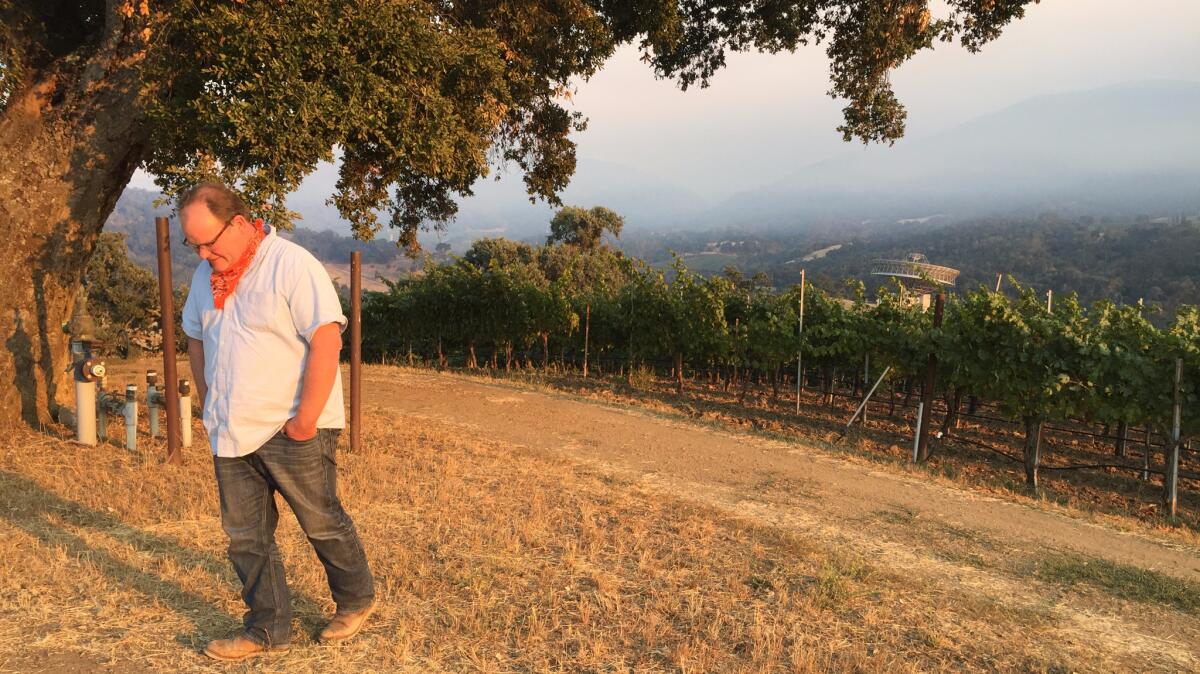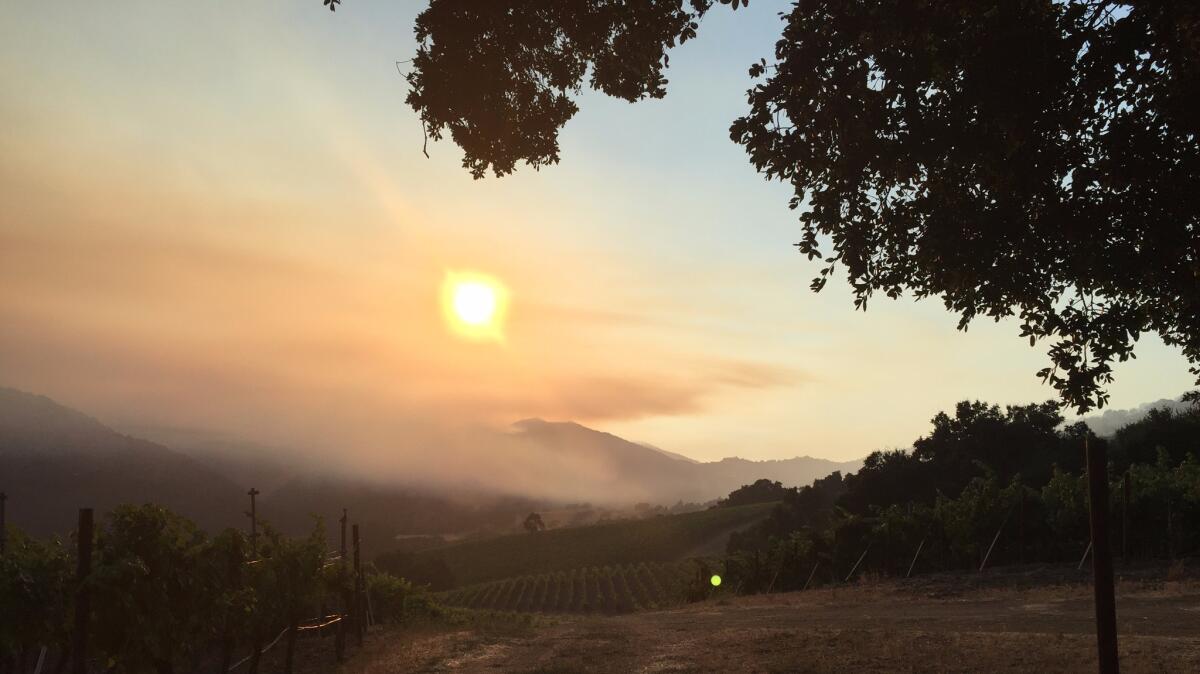A Carmel Valley vineyard manager defends his grapes against the Big Sur fire

- Share via
Reporting from Carmel Valley — Smoke is rolling down over the coastal hills. Orange helicopters with long, water-sucking stingers are thwacking around in the sky, and a fixed-wing DC-10 rumbles overhead, ready to drop its load of fire retardant.
No flames are visible, as Matt Shea and I sit in the middle of the estate vineyard he manages for Bernardus Winery in the Cachaguas Valley, a small, sheltered bowl up a very windy road on the southeastern edge of Carmel Valley.
The Soberanes fire is two miles away. But the smell of smoke is inescapable; it permeates everything.
That has the 45-year-old Shea, and other Monterey County wine growers, on edge.
The fire, near Big Sur, has been burning since July 22. So far, 51,000 acres, mostly wilderness, have been consumed. Dozens of homes have burned down, and a bulldozer operator died after his vehicle overturned in steep terrain as he cleared brush. Last week, the estate vineyard for Big Sur Winery burned down; its owner, Lenora Carey, also lost her home.
State fire officials say they do not expect to have the fire contained until Aug. 31.
By that time, the Cabernet Sauvignon, Cabernet Franc, Merlot and Malbec grapes growing next to us in Shea’s Marinus Vineyards will have changed colors, from green to purple. But right now, the fruit is going through that transition; this is the moment the grapes become vulnerable to a winemaker’s scourge called “smoke taint.”
“The potential is here,” said Shea, who celebrated his first wedding anniversary on Monday in the smoky vineyard with his wife, Katie. “We just don’t know.”
In 2008, after the Basin Complex fire, which consumed 162,000 acres and bathed Carmel Valley in smoke for weeks, Shea unwittingly harvested tainted grapes.
“We couldn’t taste it until after fermentation,” he said. “It was aging in barrels when the flavor started to develop.”
The taste was distinct.
“It had a flavor that was reminiscent of barbecue,” Shea said. “Some people loved it.”
In Carmel Valley Village, winemaker Russell Joyce frowned when I asked about his vineyard.
“I am definitely very, very nervous about smoke taint,” he said.
He grows Pinot Noir and Cabernet on six acres nearby. The wine from that vineyard, he said, commands $60 to $70 a bottle.
If his grapes sustain smoke damage, he said, he may have sell it to bottlers who will blend it with less expensive wine until the smell disappears. The thought of his estate wine — “such a pure expression of the terroir out here” — ending up as a $20 blend at Costco is distressing.
But like any grower, he knows he is at the mercy of forces beyond his control. Dozens of Monterey County wineries could eventually be affected by the smoke.
“There is nothing that we can really do about it,” said Joyce, 30, who has worked in his family’s Joyce Vineyards since he was a boy. “It’s not like you can put big wind fans like they do in Napa to blow the smoke, because there is so much smoke, you can’t get rid of it.”
Like Matt Shea, he was also caught unawares when the Basin Complex fire eight years ago smoked his grapes.
“When the wine came to fruition,” Joyce said, “there was no denying that it smelled like camp fire. I tried to use some tricks to ‘fine’ it, to strip the smell from the wine, but I was unsuccessful.”
He sold that wine, a syrah, on the bulk market.
This season after harvest, he and other winemakers are better prepared to deal with any fallout from the fire.
Because smoke is held in the skin of the grape, they will try to minimize contact between the skins and juice after grapes are pressed. Red wine, of course, takes its claret color from the skins.
“If you have red grapes,” Joyce said, “it’s probably a good idea to make rose.”
Though often eclipsed in the public imagination by the wine counties of Napa and Sonoma, Monterey produces spectacular wine.
In recent years, Monterey County has been the largest producer of Chardonnay in the country. More Pinot Noir is grown here than any other place in California.
I know in some quarters it’s not fashionable to love Chardonnay, but I don’t care. You can have your Sauvignon Blancs, your Pinot Grigios, your Gruner Veltliners. Give me that white burgundy any day — the more buttery, the better.
When I heard the Soberanes fire might affect Monterey County vineyards, I clutched my heart and screamed “Not Mer Soleil!”

Then I called Kim Stemler, executive director of the Monterey County Vintners & Growers Assn.
“Your Mer Soleil will be fine,” Stemler said.
That wine is grown in the Santa Lucia Highlands, one of Monterey County’s nine designated “American viticultural areas,” distinctive growing regions comparable to France’s “appellation d’origine controllee.” It’s well away from the Soberanes fire.
On Thursday morning, I checked back in with Shea, who has defied a mandatory evacuation order to stay on his property. The smoke, he said, had gotten a bit worse.
He knows he can do little to protect his grapes, he says, but if the fire changes direction and starts moving toward him, he wants to be on site to defend his wood home and his farming equipment. He’s not worried about his safety.
“A vineyard is probably the most defensible space, ever,” he said. “I’ve got 35 acres of dirt with green vines. To be in the center of that would be the safest place in Cachagua.”
If the fire gets too close, he said, he can take a shortcut over the mountain in his truck. “It’s just a waiting game right now.”
I wondered how he manages to sleep, under the circumstances. Quite well, he said. “A glass of pinot helps.”
Twitter: @AbcarianLAT
ALSO
Go ahead, touch that bud! Oakland museum’s (slightly dangerous) marijuana exhibit
A catastrophic oil train derailment raises fears on California’s Central Coast
She’s a retired cop, a mother of four black sons and skeptical about police shootings







